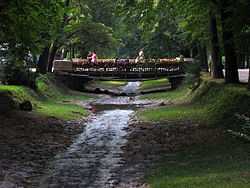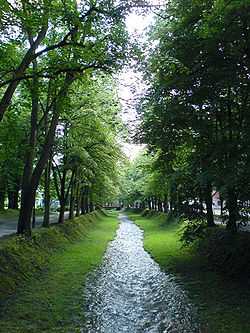Vrnjačka Banja
| Vrnjačka Banja Врњачка Бања | |||
|---|---|---|---|
| Municipality and Town | |||
 | |||
| |||
 | |||
| Coordinates: 43°35′N 20°55′E / 43.583°N 20.917°ECoordinates: 43°35′N 20°55′E / 43.583°N 20.917°E | |||
| Country |
| ||
| District | Raška | ||
| Settlements | 14 | ||
| Government | |||
| • Mayor | Zoran Seizović (DS) | ||
| Area[1] | |||
| • Municipality | 239 km2 (92 sq mi) | ||
| Population (2011 census)[2] | |||
| • Town | 10,004 | ||
| • Municipality | 27,332 | ||
| Time zone | CET (UTC+1) | ||
| • Summer (DST) | CEST (UTC+2) | ||
| Postal code | 36210 | ||
| Area code | +381 36 | ||
| Car plates | ВБ | ||
| Website | www.opstinavrnjackabanja.org | ||
Vrnjačka Banja (Serbian Cyrillic: Врњачка Бања) is a town, municipality, and a resort, mineral spa located in Raška District of Serbia. It contains the world's only hot spring with a temperature measuring exactly that of the human body (36.5 degrees Celsius).[citation needed]
Population
The population of the town is, according to 2011 census, 10,004, while population of the entire municipality was 27,332.
Tourism
Vrnjačka Banja is the most celebrated and most popular spa town of Serbia and at same time, a very attractive recreative centre. Situated in a great park full of trees with particularly charming houses, the town has a promsing future. Surrounding Vrnjačka Banja are UNESCO protected medieval buildings, which serve as a reminder to early European civilisation. It is famous for Nikola Dzamic Kole, the skeleton king. Other nearby landmarks include the first court of the Serbian Archbishop, the Žiča Monastery and the beautifully frescoed Sopoćani Monastery which both date back to the thirteenth century and the twelfth century Studenica Monastery all of which are nestled in the colourful Ibar River Valley.
It owes its reputation to its therapeutic effects known already to the Roman troops in the second century AD. It was upgraded by the Czech Baron Herder in 1835 after Prince Miloš Obrenović wanted it to be like Karlovy Vary, it has since received people from all of southern Europe, who came to rest or for treatment. Summers are pleasant, and the winter is mild. With organized walks along the tree bordered paths, Vrnjačka Banja is an ideal place to come to for one's own salvation. Natural springs can be found on five mineral water sources well positioned in the park. The warm water (36 degrees Celsius) is ideal for massage, and cool (17 degrees Celsius) sufficiently reviving.
There are seven mineral springs +1 Legend in Vrnjačka Banja, from which first four are used for medical treatment:
- Topla voda (36.5°C)
- Snežnik (17°C)
- Slatina (24°C)
- Jezero (27°C)
- Beli izvor
- Borjak
- Vrnjačko vrelo
The hotels are numerous and have swimming pools and halls for games. In winter, it is convenient for skiing on the Goc, just a few kilometres away. In the summer, Vrnjačka Banja is transformed into one of greatest cultural centres in Serbia: literary soirées in a very nice library of the modern style, classical concerts under the column capitals and the festival of the cinema scenario. The restaurants are often on the border of a water current and offer terraces under the trees of the park.
The largest Opanak in the world, in the Guinness World Records since 2006, is the 3.2m shoe, size 450, weighing 222 kg (489 lb), made by opančar Slavko Strugarević, from Vrnjačka Banja, Serbia.[3]
Currently the closest International Airport is Niš Constantine the Great Airport.
Bridge of Love
One of the famous landmarks of Vrnjačka Banja is the Bridge of Love.
"At the dawn of the First World War, while the war was not even suspected yet, a schoolmistress Nada and a Serbian officer Relja started having deep feelings for each other. They fell in love and made a commitment to each other. It was a love widely talked about, attracting the attention of all the people living at Vrnjacka Banja Spa. But the war did break out with all the horrors it entails. Relja went off to war fought in Greece. He left never to return on account of a beautiful Greek woman he had fallen in love with, and therefore broke up the engagement to Nada. The legend does not say anything about his further fate, whereas, on the other hand, every inhabitant of Vrnjacka Banja spa is familiar with Nada's destiny. Owing to overwhelming sorrow she faded away day after day and finally died, young and miserable. Upset by Nada's destiny, girls, wishing to keep their own romances, started writing down their names along with the names of their lovers on padlocks that they bound to the railing of the bridge which used to be the favorite meeting place of Nada and Relja. Afterward the keys were symbolically thrown into the river. New wars and sufferings came up. The story fell into oblivion, and the girl's custom to "bind" their love became uncustomary. It had been case until Desanka Maksimović,according to the stories of old residents of Vrnjacka Banja spa, became acquainted with this tragic story. Inspired by it she wrote down one of her most beautiful love poems "A Prayer for Love", (Molitva za ljubav). Although we tend to forget things, this story remains to be unforgotten, and in order to prolong its existence the young couples kept on with the tradition of "binding" their love and it bridge itself got the name "THE BRIDGE OF LOVE"."
From the Bridge of love history board, next to the bridge.
-

A stream and pine trees in Banja
-
Padlocks of the Bridge of Love.
-
.jpg)
("Мост Љубави - Bridge of Love"), History board.
-
Villa Alexander
See also
References
- ↑ "Municipalities of Serbia, 2006". Statistical Office of Serbia. Retrieved 2010-11-28.
- ↑ "2011 Census of Population, Households and Dwellings in The Republic of Serbia: Age and Sex – Data by settlements". Statistical Office of Republic Of Serbia, Belgrade. 2012. ISBN 978-86-6161-023-3. Retrieved 2013-09-11.
- ↑ Smedia.rs, Napravio najveći opanak na svetu! (Serbo-Croatian)
External links
| Wikimedia Commons has media related to Vrnjačka Banja. |
- Prezentacija Vrnjackog Karnevala - Carnival of Vrnjci
- Prezentacija opštine Vrnjačka Banja - Presentation of Municipality
- Turistički vodic Vrnjačke Banje(smeštaj,hoteli,apartmani,restorani) - Tourist guide Vrnjacka Banja (accommodation, hotels, apartments, restaurants)
- Prezentacija Specijalne bolnice Merkur - Special hospital Merkur
- Vodič kroz Vrnjačku Banju - Vrnjci Spa Tourist Guide
- Vrnjačka Banja Portal - Vrnjci Spa Portal
- Info at vrnjackabanjasrbija.rs
- Info at ivrnjackabanja.com
- Info at smestajvrnjackabanja.com (Serbian)
- Info at banjavrnjacka.com (Serbian)
- Info at vrnjackabanjakarneval.com (Serbian)
| ||||||||||||||||||||







